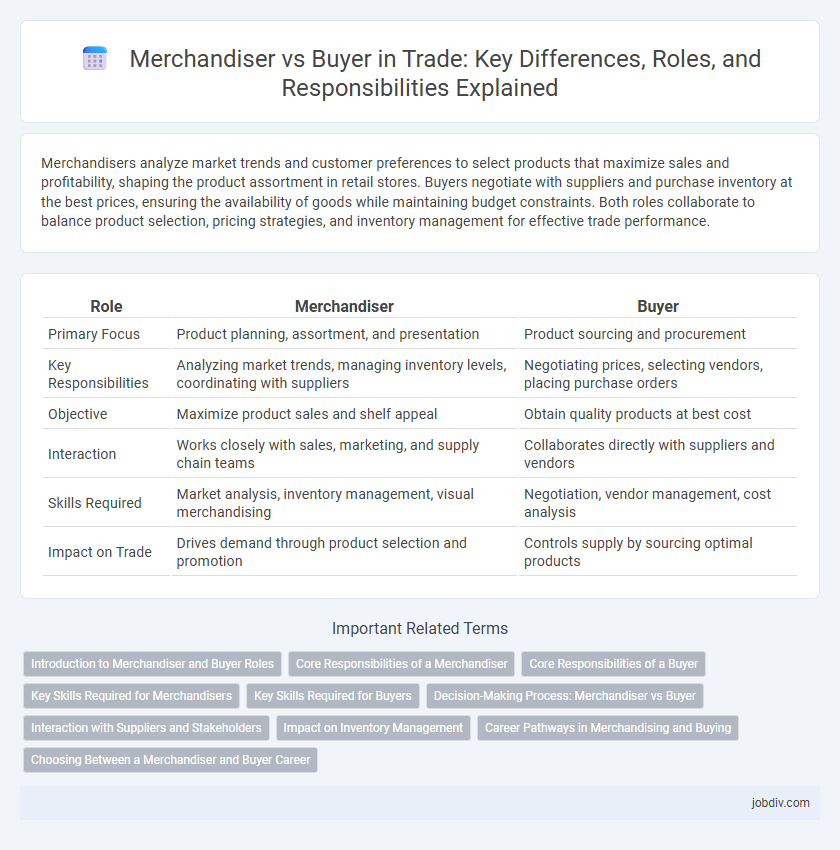Merchandisers analyze market trends and customer preferences to select products that maximize sales and profitability, shaping the product assortment in retail stores. Buyers negotiate with suppliers and purchase inventory at the best prices, ensuring the availability of goods while maintaining budget constraints. Both roles collaborate to balance product selection, pricing strategies, and inventory management for effective trade performance.
Table of Comparison
| Role | Merchandiser | Buyer |
|---|---|---|
| Primary Focus | Product planning, assortment, and presentation | Product sourcing and procurement |
| Key Responsibilities | Analyzing market trends, managing inventory levels, coordinating with suppliers | Negotiating prices, selecting vendors, placing purchase orders |
| Objective | Maximize product sales and shelf appeal | Obtain quality products at best cost |
| Interaction | Works closely with sales, marketing, and supply chain teams | Collaborates directly with suppliers and vendors |
| Skills Required | Market analysis, inventory management, visual merchandising | Negotiation, vendor management, cost analysis |
| Impact on Trade | Drives demand through product selection and promotion | Controls supply by sourcing optimal products |
Introduction to Merchandiser and Buyer Roles
Merchandisers analyze market trends and consumer demand to plan product assortments and optimize inventory levels for retail success. Buyers negotiate with suppliers to procure quality products at competitive prices, ensuring timely delivery and maintaining supplier relationships. Both roles collaborate to balance cost efficiency and product availability in the retail supply chain.
Core Responsibilities of a Merchandiser
A merchandiser focuses on planning and managing product inventory, analyzing market trends, and coordinating with suppliers to ensure timely product availability. They optimize product placement and pricing strategies to maximize sales and profitability. Merchandisers also track sales performance and customer preferences to adjust stock levels and promotional activities accordingly.
Core Responsibilities of a Buyer
A buyer's core responsibilities include sourcing products, negotiating with suppliers, and managing purchase orders to ensure timely delivery and cost-efficiency. Buyers analyze market trends to select merchandise that meets consumer demand while maintaining budget constraints. They also oversee inventory levels and collaborate closely with suppliers to optimize supply chain operations.
Key Skills Required for Merchandisers
Merchandisers require strong analytical abilities to interpret market trends and optimize product assortments for maximum profitability. Effective communication skills are essential for coordinating with suppliers, manufacturers, and retail teams to ensure timely inventory management. Proficiency in data-driven decision-making and negotiation enhances their capability to balance cost, quality, and delivery timelines.
Key Skills Required for Buyers
Buyers require strong analytical skills to evaluate market trends, negotiate prices, and select quality products that meet customer demands. Effective communication and relationship-building abilities are crucial for coordinating with suppliers and internal teams to ensure timely delivery and cost efficiency. Proficiency in inventory management and data-driven decision-making helps buyers optimize stock levels and enhance overall supply chain performance.
Decision-Making Process: Merchandiser vs Buyer
Merchandisers analyze market trends and inventory levels to make strategic decisions on product selection, pricing, and promotion, ensuring optimal stock turnover and profitability. Buyers focus on sourcing and purchasing products based on quality, cost, and supplier relationships, negotiating contracts to meet budgetary and consumer demand requirements. Both roles collaborate closely, but merchandisers emphasize market-driven strategy while buyers prioritize procurement efficiency and supplier management.
Interaction with Suppliers and Stakeholders
Merchandisers maintain close interaction with suppliers to ensure product specifications, quality control, and timely delivery, coordinating adjustments based on market demand and retailer requirements. Buyers focus on negotiating pricing, contract terms, and procurement schedules with suppliers to optimize cost-efficiency and inventory levels, while collaborating with internal stakeholders such as marketing and sales teams to align purchasing decisions with business strategies. Both roles require effective communication with suppliers and cross-departmental teams to balance supply chain efficiency and customer satisfaction.
Impact on Inventory Management
Merchandisers directly influence inventory management by forecasting demand and coordinating product assortment to minimize stockouts and overstock situations. Buyers focus on selecting suppliers and negotiating purchase terms, shaping inventory levels through procurement decisions and lead time management. Effective collaboration between merchandisers and buyers optimizes inventory turnover rates and reduces carrying costs.
Career Pathways in Merchandising and Buying
Career pathways in merchandising emphasize product selection, inventory management, and market trend analysis to ensure optimal stock levels and customer satisfaction. Buyers focus on negotiating with suppliers, sourcing products, and managing purchase contracts to secure quality goods at competitive prices. Both careers require strong analytical skills and industry knowledge, with merchandising leaning toward strategic planning and buying centered on procurement execution.
Choosing Between a Merchandiser and Buyer Career
Choosing between a merchandiser and buyer career depends on skills in inventory management versus negotiation and market analysis. Merchandisers focus on product assortment, pricing strategies, and sales forecasting to optimize store performance. Buyers prioritize vendor relationships, procurement decisions, and cost control to ensure quality goods meet consumer demand efficiently.
Merchandiser vs Buyer Infographic

 jobdiv.com
jobdiv.com